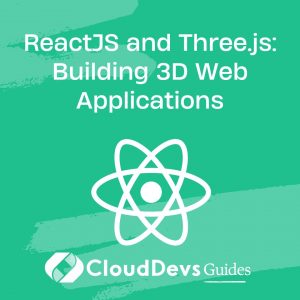ReactJS and Three.js: Building 3D Web Applications
Creating engaging web applications has become a key focus for developers, and 3D graphics are an exciting way to enhance user experiences. Two popular technologies, ReactJS and Three.js, offer a powerful combination for building dynamic and immersive 3D web applications. In this blog, we’ll explore how these tools can be used together to create stunning 3D scenes and interactive elements on the web.
Introduction to ReactJS and Three.js
What is ReactJS?
ReactJS, developed by Facebook, is a JavaScript library for building user interfaces. It’s known for its component-based architecture, allowing developers to create reusable UI components. React’s efficient rendering using the Virtual DOM makes it ideal for building high-performance web applications.
What is Three.js?
Three.js is a JavaScript library that makes it easy to create 3D graphics in the browser using WebGL. It abstracts the complexities of working directly with WebGL, providing a simple and powerful API for creating 3D scenes, animations, and more. With Three.js, developers can create complex 3D environments with ease.
Setting Up a ReactJS and Three.js Project
To get started, you’ll need to set up a React project and integrate Three.js. Here’s a simple example to illustrate the process.
Setting Up React
First, create a new React application using Create React App:
```bash npx create-react-app react-three-app cd react-three-app ```
Next, install Three.js:
```bash npm install three ```
Creating a Basic 3D Scene with Three.js
Once you’ve set up your React app and installed Three.js, you can create a basic 3D scene. Let’s create a simple rotating cube.
```javascript
// src/App.js
import React, { useRef, useEffect } from 'react';
import * as THREE from 'three';
function App() {
const mountRef = useRef(null);
useEffect(() => {
// Set up scene, camera, and renderer
const scene = new THREE.Scene();
const camera = new THREE.PerspectiveCamera(75, window.innerWidth / window.innerHeight, 0.1, 1000);
const renderer = new THREE.WebGLRenderer({ antialias: true });
renderer.setSize(window.innerWidth, window.innerHeight);
mountRef.current.appendChild(renderer.domElement);
// Create a cube
const geometry = new THREE.BoxGeometry();
const material = new THREE.MeshBasicMaterial({ color: 0x00ff00 });
const cube = new THREE.Mesh(geometry, material);
scene.add(cube);
camera.position.z = 5;
// Animation loop
const animate = () => {
requestAnimationFrame(animate);
cube.rotation.x += 0.01;
cube.rotation.y += 0.01;
renderer.render(scene, camera);
};
animate();
// Cleanup on component unmount
return () => {
mountRef.current.removeChild(renderer.domElement);
};
}, []);
return <div ref={mountRef}></div>;
}
export default App;
```
In this example, we set up a basic Three.js scene with a rotating cube. We use the `useRef` hook to keep a reference to the DOM element where the scene will be rendered. The `useEffect` hook is used to initialize the scene, camera, and renderer, and to start the animation loop.
Advanced Techniques: React Three Fiber
For more complex 3D applications, integrating Three.js with React can be made easier using **React Three Fiber**. This library provides a React renderer for Three.js, allowing developers to use JSX syntax to create and manage 3D scenes.
Example with React Three Fiber
```javascript
// src/Scene.js
import React from 'react';
import { Canvas } from '@react-three/fiber';
import { MeshWobbleMaterial, OrbitControls } from '@react-three/drei';
function Scene() {
return (
<Canvas>
<ambientLight intensity={0.5} />
<spotLight position={[10, 10, 10]} angle={0.15} />
<mesh rotation={[90, 0, 20]}>
<boxBufferGeometry attach="geometry" args={[1, 1, 1]} />
<MeshWobbleMaterial attach="material" color="blue" speed={1} factor={0.6} />
</mesh>
<OrbitControls />
</Canvas>
);
}
export default Scene;
```
In this code snippet, `React Three Fiber` and `@react-three/drei` are used to create a scene with a blue, wobbly cube and orbit controls for interaction. This setup simplifies the process of working with Three.js in a React environment, providing an intuitive and declarative way to build 3D applications.
Conclusion
Combining ReactJS and Three.js opens up a world of possibilities for creating interactive and visually stunning web applications. Whether you’re building simple 3D models or complex scenes, the synergy between these two technologies can help you achieve your vision with efficiency and ease. By leveraging tools like React Three Fiber, developers can integrate 3D graphics seamlessly into their React applications, enhancing the user experience and providing a modern, immersive interface.
Further Reading
Table of Contents










